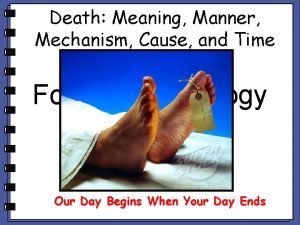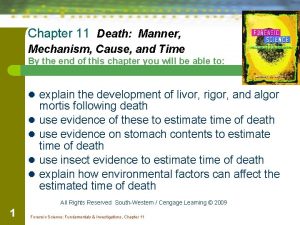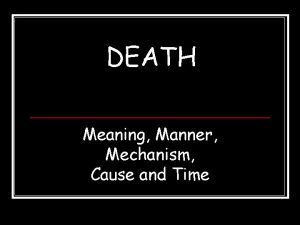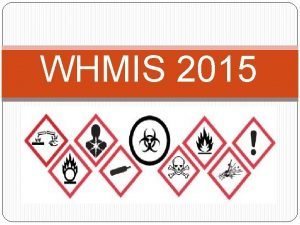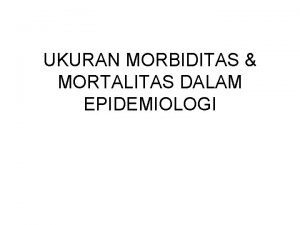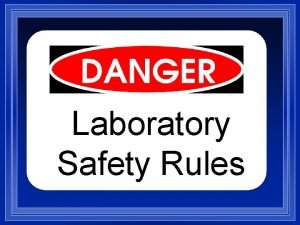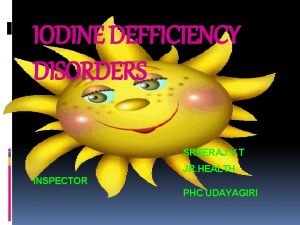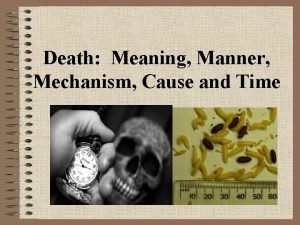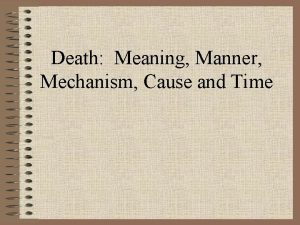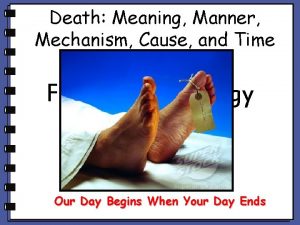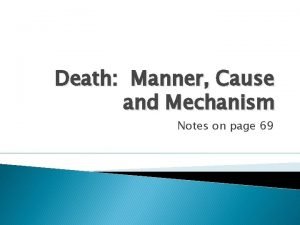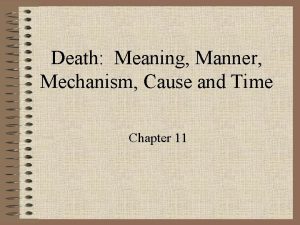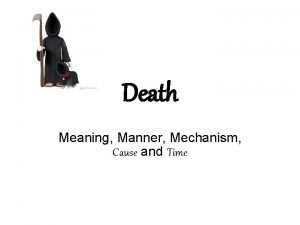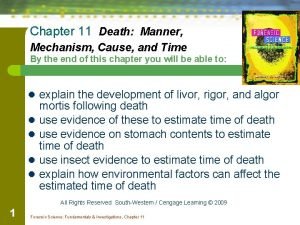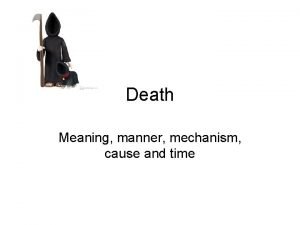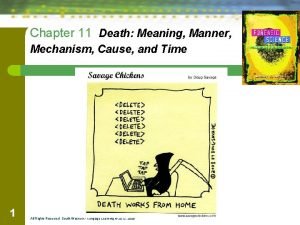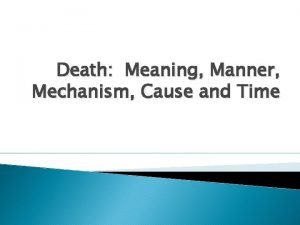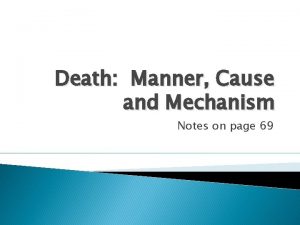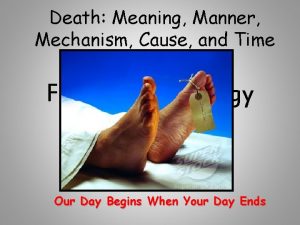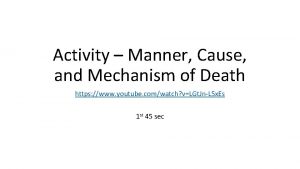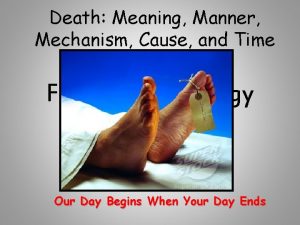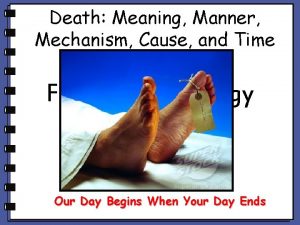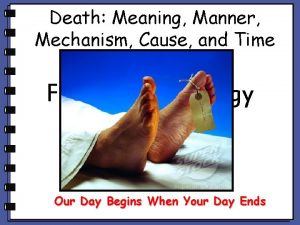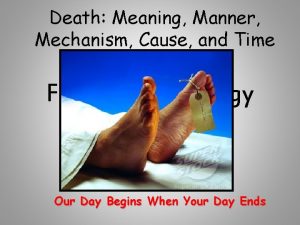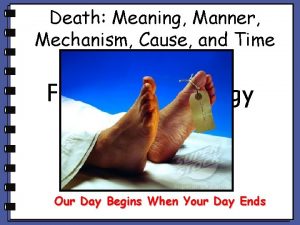Cause and Mechanism of Death 1 Cause of


































- Slides: 34

Cause and Mechanism of Death 1. Cause of death- a disease or injury that initiated the lethal chain of events , however prolonged or brief, that led to death of the person 2. Mechanism of death- a biochemical or physiologic abnormality produced by the cause of death that is incompatible with life

Manner of Death • defined as the fashion in which the cause of death came to be – Four manners of death: a. Natural b. Accidental c. Suicidal d. Homicidal

Time of Death – Three methods used to estimate time of death • Rigor Mortis • Livor Mortis • Algor Mortis

Time of Death – Rigor Mortis- stiffening of muscles which occurs following death: • Results from a chemical reaction with glycogen • Normally sets in about 4 hours after death • Exceptions include instant rigor mortis and death from electric shock- both create shorter onset of rigor mortis from time of death • Generally disappears 24 -48 hours after death


Time of Death • Livor Mortis- discoloration of body from settling of red blood cells after blood stops circulating (aka lividity) – In light skinned individuals, lividity may be seen within an hour after death – In dark skinned individuals, lividity may not be able to be seen – Substantial blood loss may result in little lividity – Lividity becomes fixed about 12 hours after death, and slowly disappears with decomposition after 36 hours


Time of Death • Algor Mortis- cooling of the body after death, and assumes ambient temperature is lower than body temperature

Classification of Traumatic Deaths – Traumatic deaths are classified as a. Mechanical- sharp and blunt trauma b. Chemical- poisoning c. Thermal- exposure to excessive heat or cold d. Electrical- electrocution

Mechanical Trauma 1. Mechanical trauma occurs when applied physical force exceeds the strength of the tissue to which the force is applied – Sharp objects produce incised and stab wounds • Example- a stab wound by an object, such as a knife, which has more depth than its other dimensions – Blunt objects produce lacerations • Example- a wound caused by an item such as a brick or stone, which creates significant damage


2. Firearm Injuries A. Firearm projectiles cause blunt trauma B. Most common suicidal and homicidal wounds are results of firearm blunt trauma Forensic Firearm Analysis

Firearm Injuries C. Gunshot wounds can be classified in two manners 1. Penetrating: creates an entrance wound but not exit wound- projectile must be recovered from body to confirm this 2. Perforating: creates both an entrance and exit wound- no projectile recovered from body

More on Firearm Injuries • Entrance wounds are generally round due to being fired from a rifled barrel • Rotation of bullet during flight causes wound to be round or elliptical • Yawing- when a bullet enters a body sideways • Yawing does not normally occur, but can when bullet passes through a medium thicker than air • Another Video on Ballistics



D. Blunt Force Trauma 1. Blunt force trauma can result from motor vehicle accidents 2. Generally, with exception of gunshot wounds, homicidal blunt force trauma in an adult requires lethal head injury – injuries to other areas rarely produce death 3. In children, head injuries are most common, but chest and abdominal trauma with cuts to spleen, liver and heart are seen

Blunt Force Trauma 4. Most common mechanism of death from blunt force trauma is drowning in blood that has aspirated into lungs 5. Contusion- accumulation of blood in tissue outside the blood vessels- most commonly caused by blunt force trauma 6. Pattern of blunt object may be transferred to person who is struck

Chemical Trauma 1. Ethyl alcohol, (ethanol) active ingredient in beer, wine and liquor is a contributory factor in 50% of traumatic deaths 2. Alcohol is a depressant: it slows reactions and communications from the brain and spinal cord neurons 3. Person under influence of alcohol breathes slower and slower until lack of oxygen causes death

Chemical Trauma 4. Barbituates, diazepams, and opiates produce deaths in same manner as death from alcohol 5. Cocaine is a stimulant and high doses can cause seizures, extremely high body temperatures and uncontrolled quivering of heart

Chemical Trauma 6. Carbon Monoxide (CO) is an odorless, colorless, explosive gas 7. Deaths due to CO may be accidental, suicidal or homicidal 8. CO kills by asphyxiation 9. Lungs show bright cherry red color when carbon monoxide poisoning is present- this can determine if someone died in a fire or was placed into the fire after death

Chemical Trauma • Cyanide is generally available as sodium or potassium salt • Has a distinct odor like almonds • Up to 50% of the population can’t smell cyanide • Forensic Pathologists should be able to smell cyanide, especially in cases of suspected of suicide by cyanide.

Thermal Trauma • Exposure to excessive heat or cold may produce death • Exposure to either cause breakdown of body mechanisms that maintain body temperature around 37 degrees Celsius • Hypothermia death common in individuals who are intoxicated by alcohol- alcohol increases loss of body heat and reduces appreciation of the cold

Thermal Trauma • Hyperthermia – heat related illness which can cause death • The ability to maintain homeostasis declines as people age • Thermal burns are wounds caused by hyperthermiatemperatures above 65 degrees C (140 F) will produce burns upon direct contact • People who die at fires most commonly die from inhalation of Carbon monoxide • People who die with only a 1 -2% CO level in a burned structure is presumptive evidence they were dead or not breathing when fire started

Electrical Trauma • Passage of electricity through a person may cause death by a number of different mechanisms – Low voltage AC current ( under 1000 volts) crosses the heart and ventricular fibrillation is experienced (nonpropulsive quivering of heart) that leads to nonresucitability within minutes – Heart normally produces 300 quivers per minute – AC produces 3600 quivers per minute

Struck by lightning

Electrical Trauma • In high voltage exposures: – Poration occurs: result of flow of current through tissues which creates holes in membrane of cells. This creates a devastating loss of limbs in person exposed to high voltage – Electrical current burns person in a fraction of a second

Asphyxias • Asphyxia- interruption of oxygenation to brain • Drowning- death from asphyxiation due to immersion in water or other liquid • Water enters stomach, then coughing and reflex inhalation cause water to enter smaller air passages of lungs • Loss of consciousness occurs within 1 -2 minutes, unless additional air can be obtained

Asphyxias • Diatoms assist in providing clues to determine time and place of drowning – Diatoms are small unicellular one celled organisms found in salt or fresh water – Contain silica, and resist degradation – During late stages of drowning, diatoms in aspirated water are circulated by heart to organs, including bone marrow – Not normally found in bone marrow, diatoms can assist especially if body is severely decomposed or skeletonized


Asphyxias • Asphyxia may be caused by: – Manual strangulation using hands – Strangulation by ligature

Asphyxias • Results of manual strangulation using hands • Typically, manual strangulation fractures the cornu of the thyroid cartilage • Even more common in manual strangulation is hemorrhage of muscles in neck

Asphyxias • In manual strangulation, fracture of hyoid bone in neck is infrequent, and seen in elderly women who have osteoporosis, which makes fracturing the bone easier

Asphyxias • Ligature strangulation, whether by hanging or garroting, generally results in findings of a groove in the neck
 Manner mechanism and cause of death
Manner mechanism and cause of death Chapter 11 death meaning manner mechanism
Chapter 11 death meaning manner mechanism Manner mechanism and cause of death
Manner mechanism and cause of death Difference between somatic and cellular death
Difference between somatic and cellular death Mechanism of death definition
Mechanism of death definition Ter thin client
Ter thin client Greylag goose egg-retrieval behavior
Greylag goose egg-retrieval behavior Proximate causation vs ultimate causation
Proximate causation vs ultimate causation Difference between innate and learned behavior
Difference between innate and learned behavior Whmis is an acronym that stands for:
Whmis is an acronym that stands for: Morbiditas
Morbiditas The case of dena schlosser
The case of dena schlosser Vladimir lenin cause of death
Vladimir lenin cause of death Short exposure can cause death
Short exposure can cause death How apostles died
How apostles died Harry houdini death date
Harry houdini death date Peter eckersley cause of death
Peter eckersley cause of death Edward fudge cause of death
Edward fudge cause of death Portia white cause of death
Portia white cause of death Lyle alzado cause of death
Lyle alzado cause of death Maria emília miranda
Maria emília miranda Antonio vivaldi cause of death
Antonio vivaldi cause of death Was born in salzburg austria on january 27 1756
Was born in salzburg austria on january 27 1756 Wolfgang amadeus mozart death cause
Wolfgang amadeus mozart death cause Brock franklin
Brock franklin Chrisomes death
Chrisomes death Charles capps cause of death
Charles capps cause of death Catharina bolnes
Catharina bolnes Daily iodine requirement
Daily iodine requirement Ning li illness
Ning li illness Jana novotna cancer type
Jana novotna cancer type Mali empire religion
Mali empire religion Rajdeep kaur death reason
Rajdeep kaur death reason Cause of death
Cause of death What was humpty dumpty's cause of death geometry
What was humpty dumpty's cause of death geometry
